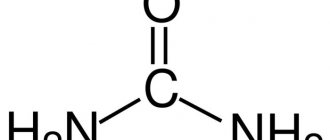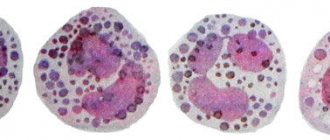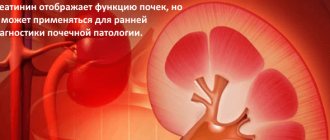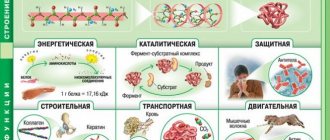Sometimes, after performing a standard blood test, specialists record an insufficient amount of urea. This parameter indicates the concentration of a nitrogen-containing compound synthesized as a result of the active breakdown of proteins and then naturally excreted from the human body along with urine.
Urea deficiency is not a common medical phenomenon, but the detection of such a malfunction is the basis for a more extensive examination: only within its framework can one identify the true “root” of the ailment and promptly draw up a treatment plan that guarantees recovery without further complications. Why is there a condition in which urea in the blood is low?
Briefly about urea
Every day, the human body undergoes processes of breakdown of proteins, both its own and those supplied with food. The resulting amino acids undergo a series of biochemical transformations in the liver, which allow them to be reused for the “construction” of new cells and tissues.
In this case, a by-product such as urea is formed. This chemical compound is osmotically active and has a small molecular weight, which reflects the state of the concentration function of the kidneys.
Its level in blood plasma depends on the balance between synthesis and excretion, therefore urea testing is used primarily to assess the excretory function of the kidneys. In addition, it indirectly gives an idea of the functioning of the liver and the condition of muscle tissue.
Low urea in the blood: causes, diagnosis and treatment
The liver is the site of urea formation
Urea is the end product of protein metabolism. Proteins are made up of amino acids, which form water, carbon dioxide and ammonia when broken down.
Reason for downgrade
In a healthy person, the synthesis of nitrogenous bases is determined by the nature of nutrition. But often accidentally discovered deviations in tests make it possible to timely identify serious diseases at an early stage.
Physiological
Low urea in the blood can also be observed in the following functional conditions, that is, treatment does not require:
- insufficient consumption of protein foods;
- vegetarianism;
- inadequate diets associated with prolonged fasting;
- in children of the first years of life (active tissue growth);
Low urea in the blood during pregnancy (especially in the first and third trimesters) is not a cause for concern if all other test results are normal. The changes are due to an increase in total blood volume and high energy costs, which is necessary for the proper development of the fetus.
Also, a temporary change in the indicator occurs after intravenous administration of large volumes of medicinal solutions or blood purification procedures (hemodialysis, plasmapheresis).
Pathological
Blood urea is low in the following diseases:
- acute intoxication (poisoning with phosphorus, arsenic compounds);
- acromegaly (a disease in which certain parts of the human body become pathologically enlarged);
- acute or chronic kidney damage;
- malabsorption syndrome (insufficient absorption of substances in the intestine);
- severe liver damage: viral hepatitis, cirrhosis, cancer;
- organ transplantation;
- hepatic encephalopathy (up to the development of coma);
- congenital defects of enzyme systems.
Impaired liver and kidney function also occurs when long-term treatment with certain medications (hormones, antibiotics, chemotherapy) is required.
What can high urea levels cause?
Urea in small quantities is quite safe and non-toxic. But a high level is a sign of kidney dysfunction, which means that toxic metabolic elements are not removed from the body by the kidneys. This leads to water-salt and acid-base imbalance. Hormonal disturbances occur, gradually leading to multiple organ failure.
It is also important that dangerous ammonia accumulates in the body and tissue poisoning occurs. If the level of urea is not reduced in time, then the entire body becomes saturated with it, and irreversible processes (necrosis) begin in the brain cells. Against this background, the patient may develop psychological and neurological diseases
Associated symptoms
The more severe the cause-significant condition, the more pronounced the clinical signs. Therefore, symptoms may vary or be completely absent. Among them are the following:
- poor appetite, nausea, vomiting, refusal to eat (anorexia);
- Children often have bloating, indigestion (diarrhea, constipation), cramps;
- prolonged fever;
- the skin becomes dry, nail deformation and hair loss are possible;
- severe weakness, headache, fatigue;
- edema, an increase in abdominal volume disproportionate to the limbs (free fluid in the abdominal cavity - ascites);
- urinary retention, discomfort and pain when urinating;
- skin itching, drowsiness;
- vomiting or bloody bowel movements;
- decreased libido, menstrual irregularities, erectile dysfunction.
It is important to know! Features of the anamnesis will depend on the specific disease and its course in the patient. It is mostly impossible to make a diagnosis based only on changes in one biochemical indicator.
Diagnostics
Entering the blood from the liver, urea is no longer used (the kidneys continuously get rid of it), so normally it is always present in moderate quantities. Its content is checked in the following cases:
- to assess renal function before prescribing pharmaceuticals;
- when a person is hospitalized in a hospital;
- to control the course of chronic diseases (before, during and after therapy).
Methodology
In a biochemical blood test, the urea level is always assessed against the background of other indicators (creatinine, transaminases, alkaline phosphatase, bilirubin fractions), since in itself it is not informative. In modern laboratories, ready-made test systems are used for this.
In addition, the following methods are used:
- Gasometric (inaccurate, since all nitrogen-containing substances are determined).
- Enzymatic (during the hydrolysis of urea, accounting is done by the amount of ammonia released).
- Semi-quantitative (indicator paper).
- Firon reaction and Rashkovan method (when interacting with the reagent, a colored solution is formed).
- Calorimetry.
According to the doctor's indications, additional diagnostic measures are prescribed (urinalysis, ultrasound of the abdominal organs) and consultations with other specialists (nephrologist, infectious disease specialist, endocrinologist).
Preparation
Venous blood sampling is best done in the morning on an empty stomach. The day before you should adhere to the following rules:
- before the procedure, the last meal is taken 8-12 hours, which just falls during the night period;
- in 2-3 days you should completely eliminate the use of alcoholic beverages and, if possible, smoking;
- You are allowed to drink non-carbonated mineral water;
- food consumed the day before the study should not include large amounts of protein (complete refusal is even more prohibited).
In order for the result to be reliable, you need to avoid stressful situations and heavy physical activity (sports training, gym classes). In private laboratories, blood sampling is allowed during the day, but only 4-5 hours after a light breakfast/lunch.
How to normalize urea content
Low urea content is a symptom, but not a disease. Therefore, in order for the level of the substance to return to optimal limits, it is necessary:
- Contact your doctor and insist on an examination. This will help identify the root cause of the condition.
- Follow all doctor's recommendations. Surely he will prescribe not only drug treatment, but also advise how to adjust the daily menu. You can't do without eating proteins.
Getting rid of the disease, which provokes a decrease in urea levels, should balance its content in the blood.
A decrease in urea concentration, with the exception of natural processes, signals possible hidden diseases. Therefore, if test results show a drop in the level of a substance below acceptable limits, consulting a doctor will help prevent negative consequences.
Date: 12/10/2016.
Decoding
The concentration of urea in plasma is affected by gender and age, which the doctor must take into account when assessing the results. So, in women and children it is slightly lower due to small muscle mass (compared to men). With age, the functioning of the kidneys and other internal organs weakens.
Standards may vary depending on the region and the methodology used by the laboratory. On average, urea should be within the following values:
| Age, years | Depending on gender, mmol/l | |
| male | female | |
| 20 — 50 | 3,2 – 7,3 | 2,6 – 6,7 |
| Over 50 | 3 – 9,2 | 3,5 – 7,2 |
| 14 — 19 | 2,9 – 7,5 | |
| 4 — 13 | 2,5 — 6 | |
| First years of life | 1,8 — 6 | |
| Newborns | 1,4 – 4,3 | |
Treatment
A decrease in serum urea can be eliminated by treating the disease that led to it. Therefore, the scope of therapeutic measures will vary in individual cases.
Medication
Physiological changes resolve on their own, often without requiring additional medications. In case of serious illnesses, the following medications may be prescribed:
- Diuretics: Furosemide, Hydrochlorothiazide.
- Nonsteroidal anti-inflammatory drugs: Ketoprofen, Diclofenac.
- Angioten-converting enzyme inhibitors (ACE inhibitors): Captopril, Enalapril.
- Calcium channel blockers: Verapamil, Nifedipine.
- Antibiotics and antivirals (depending on the pathogen).
- Glucocorticoids: Prednisolone, Dexamethasone.
- Vitamins: Cyanocobalamin, Pyridoxine.
Attention! If liver or kidney failure decompensates, an organ (or part thereof) transplant may be required.
Correction of nutrition and lifestyle
There is no special diet required to increase urea levels to normal levels. Nutrition is selected individually depending on the causally significant factor. For children with protein-energy malnutrition, it is necessary to ensure an optimal sleep schedule appropriate for their age and moderate physical activity. The diet should be balanced in protein and carbohydrate content.
Adequate intake of nutrients is carried out while maintaining water balance (at least 1.5-2 liters per day). In addition, the diet should promote daily bowel movements. In severe cases, the doctor decides on additional prescription of vitamins and amino acid solutions for parenteral nutrition.
What if there is too much urea?
If the level of urea in the blood increases noticeably, this certainly indicates the development of serious pathological abnormalities. The most serious causes of this phenomenon are considered to be pathologies that accelerate protein decomposition and provoke pathological abnormalities in organic structures such as prostate adenoma or bladder tumor, endocrine pathologies or acute kidney failure.
Also, an increased content of urea is found in severe burns, severe infectious lesions, myocardial failure and leukemia, bleeding or intestinal obstruction. If an increase in urea accompanies any pathology, then we are talking about uricemia or uremic syndrome.
So, urea is a secondary metabolic product that has no metabolic significance. They are transported through the bloodstream into the kidney tissue and then into the urine. At the same time, urea levels in the blood help specialists correctly assess the functions of the kidney, liver and muscle structures. If the levels are lower in pregnant women, then this is quite normal, but in healthy people, a decrease in urea indicates liver pathologies, and an increase indicates kidney disease.
Source











